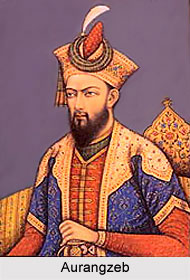 Religious policy of Aurangzeb was based on the Islamic theory of kinship. Aurangzeb felt that he was superior not only had he become superior to administer the empire in a better way but also to protect and strengthen Islam particularly its Sunni faith. He was a strict follower of the Sunni sect, to the extent that he persecuted the members of the Shia sect. In order achieve his objective of strengthening Islam, he imprisoned his father, killed his brothers, forced his son Akbar to revolt and pass a miserable life. He also compelled the Rajputs, the Jat, the Sikhs and the Marathas to rebel, destroyed the states of Bijapur and Golkonda and imposed political, economic, and social disabilities on his Muslim subjects with a view to convert them to Islam. Aurangzeb believed that all Mughal rulers who ruled prior to him committed one blunder of not trying to establish the supremacy of Islam in India. He attempted for it during his life time because he believed that it was the foremost duty of a Muslim king.
Religious policy of Aurangzeb was based on the Islamic theory of kinship. Aurangzeb felt that he was superior not only had he become superior to administer the empire in a better way but also to protect and strengthen Islam particularly its Sunni faith. He was a strict follower of the Sunni sect, to the extent that he persecuted the members of the Shia sect. In order achieve his objective of strengthening Islam, he imprisoned his father, killed his brothers, forced his son Akbar to revolt and pass a miserable life. He also compelled the Rajputs, the Jat, the Sikhs and the Marathas to rebel, destroyed the states of Bijapur and Golkonda and imposed political, economic, and social disabilities on his Muslim subjects with a view to convert them to Islam. Aurangzeb believed that all Mughal rulers who ruled prior to him committed one blunder of not trying to establish the supremacy of Islam in India. He attempted for it during his life time because he believed that it was the foremost duty of a Muslim king.
Aurangzeb was non-tolerant towards other religious beliefs besides Islam. He stopped celebrating the Hindu festivals like Holi, Diwali etc. at the court. Nearly all famous temples of northern India including the temple of Vishwanath at Varanasi and Somnatha at Patna were destroyed during the reign of Aurangzeb. In April 1679 A.D., Jizya was imposed on the Hindus. Pilgrimage tax on the Hindus was also revived and while the Muslim traders remained free from tax, the Hindu traders were asked to pat a certain per cent of the value of their commodities as tax. All these disabilities were imposed on the Hindus with a view to force them to accept Islam.
As regards Islam, he reinforced the religion rather stringently on its followers. He framed certain laws to be observed by the Muslims as their religious duty and appointed a new class of officers who were assigned the duty to enforce these laws. These officers were given powers to punish all the people who were found guilty of blasphemy. That is why even liberal Shias and Sufis were also punished during the reign of Aurangzeb. He displayed a particular animosity towards the Shia sect and persecuted them with and intent of trying to establish the superiority of the Sunni sect. There were a number of different ways in which he tried to put down the Shias and curb their practices. One su8ch measures was the banning of the Tazia procession. Shias observe ten days of mourning in Muharram in remembrance of the martyr Imam Hussein, then on the tenth day there is a big procession. A Tazia is built, a replica of his cenotaph, to which are added various symbols of Hazrat Ali and his family. The Tazia, and a horse representing the Holy Caliph`s horse, a mount kept especially for this occasion which nobody is allowed to ride, take their places in the procession, while the mourners follow reciting elegies and chanting, with some indulging in self-flagellation. It is a highly emotionally charged march that many times has led to sectarian conflict. Even though he allowed this practice to be followed in the early part of his reign, he later banned the Tazia procession.
However, in his personal behaviour, he displayed a rather bigoted attitude. For instance, once in a letter to Asad Khan, his favourite vizier, he writes about an Afghan prince who had shown him a beautiful ceremonial dagger which had been forged in Ferghana, the country Babur originally came from. The Afghan prince boasted that the name of the dagger was even more beautiful than its engravings. Its name was `Killer of Shias,` and Aurangzeb said he wanted two or three similar daggers with the same name. On the other hand, he was full of praise for Amin Khan Hafiz, son of his very dear friend Mir Jumla, both of whom were Shias, and he even made Amin Governor of Gujarat from 1672 to 1682. Also, his wife Dilras Begum, whom Aurangzeb loved dearly and whose every wish he tried to grant, was a devout Shia, and he had let her raise their son Azam in this faith. In his own court, the Prince organized debates between Shia and Sunni Ulema. Thus there spears to be a strange contradiction in the general policy that Aurangzeb followed towards the practitioners of Shiasm. While on the one hand he did everything possible to curb their religious influence on the other hand he also seemed to have adopted a liberal attitude towards the believers at times.
The religious intolerance practiced by Aurangzeb led to several revolts by the Marathas, Satnamis, Sikhs and the Jats. These revolts destroyed the peace of the empire, disrupted its economy and weakened its military strength which, ultimately, led not only to the failure of Aurangzeb but also to the downfall of the Mughal Dynasty.



















